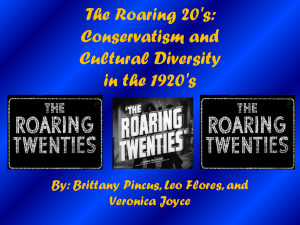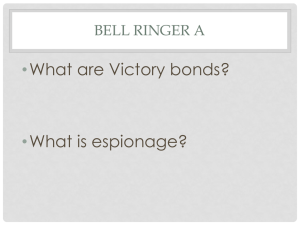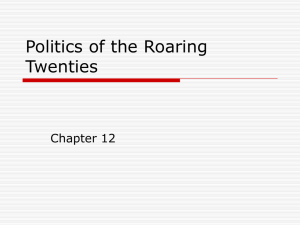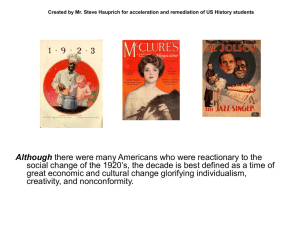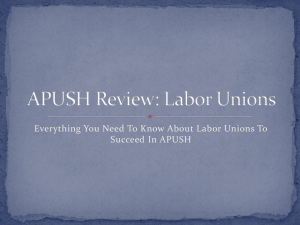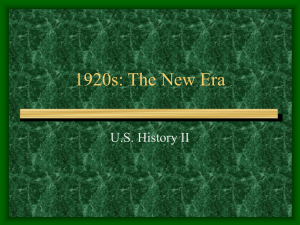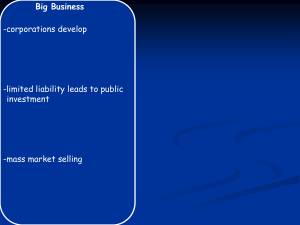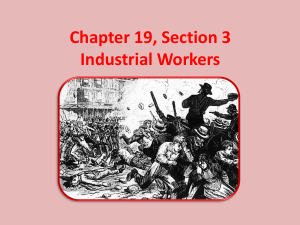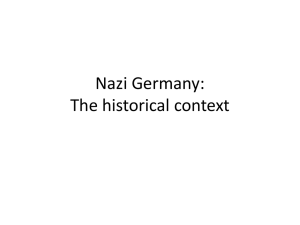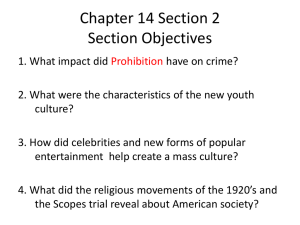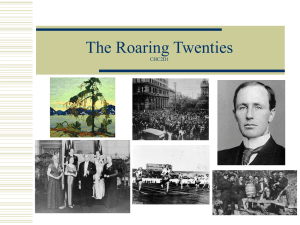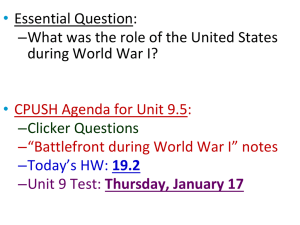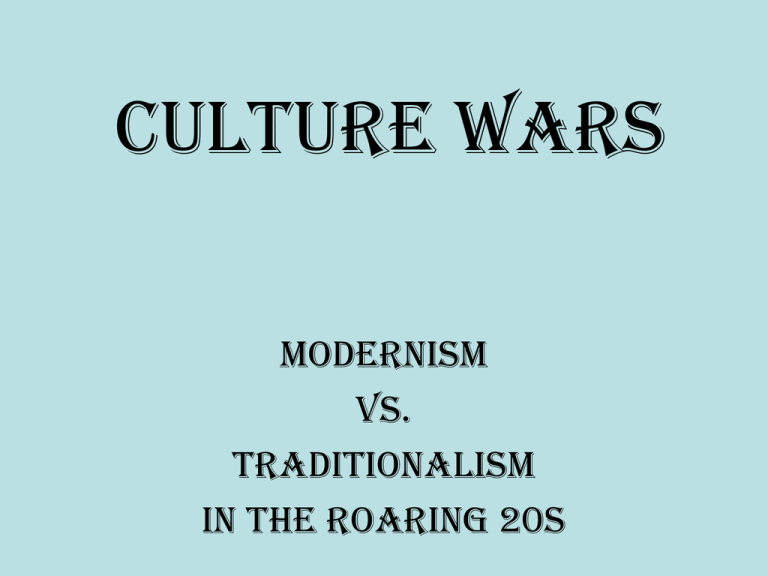
Culture Wars
Modernism
vs.
Traditionalism
in the Roaring 20s
The Battles
1.
2.
3.
4.
5.
6.
7.
8.
9.
10.
11.
Red Scare (1919-20)
Harlem Renaissance
“The Native Stock” vs. Hyphenates & Blacks
Sex & Gender: The New Woman, Birth Control & The Freudian
Revolution
Religion: Evolution vs. Creationism in Scopes Trial
Prohibition & Organized Crime
Technology: Automobile Revolution & Aviation
Mass Consumerism & Advertising: Radio and Movies
Pop Culture & The Fad Life
The “Lost Generation” of American Literati
American Architecture: Frank Lloyd Wright
…you are encouraged to explore how all of these battles are related.
Red Scare (1919-20)
• US economy not ready for returning soldiers from
Europe
• Millions of returning veterans furious at the
economic situation
• Largely result of inflation during the war. Price of
food doubled; cost of clothing nearly tripled
• 4 million workers went on strike after WWI
• 20% of all workers unionized; largest proportion in
U.S. history.
• Wilson lifted war-time price controls but refused to
lift anti-strike regulations.
• Corporate leaders repudiated war-time concessions
they had made to labor.
• Labor had sacrificed during the war and would now
expect payback.
• US Veterans…
Red Scare (1919-20)
Seattle General Strike (Jan, 1919) – most famous general strike in U.S. history.
35,000 shipyard workers failed to get wage increase to compensate for inflation during the
war. 60,000 followed
•
Seattle mayor called for federal troops to head off the "anarchy of Russia." Later toured
U.S. bragging he had put down Bolshevik uprising
2. Boston Police strike (Sept. 1919)
•
Over 70% of Boston’s 1,500 policemen went on strike seeking wage increases & right to
unionize
•
Some worked between 73 to 98 hrs per week with no pay for parade duty.
•
Gov. Calvin Coolidge called out the National Guard stating there was "no right to strike
against the public safety by anybody, anywhere, anytime". Coolidge became a national
hero \
•
Refused Gompers’ offer to settle strike, demanding police had no right to form a union.
•
Most frightening strike in the minds of many Americans.
•
Police went on strike in 37 other cities.
•
Police were fired and a new force was recruited from national guards.
3. Steel Strike (Sep. 1919)
•
Nearly half of nation’s steel workers worked for USX
•
AFL attempted to organize the steel industry in major shift—unskilled workers
•
Sought 8-hr day, 6-day week, end to 24-hr shift every 2 weeks, & union recognition
•
Judge Elbert H. Gary, head of USX refused to negotiate on grounds that representatives of
AFL were not his employees.
•
After much violence and the use of federal and state troops, the strike was broken by Jan
1920.
•
Failure of strike marked hardening of Americans on labor matters.
1.
•
Red Scare (1919-20)
Palmer Raids
•
After bomb scares, Wilson’s Attorney General, A. Mitchell Palmer, got $500K from
Congress to "tear out the radical seeds that have entangled American ideas in their
poisonous theories."
•
May Day violence against Socialists by servicemen in Boston and NY
•
Terrorist bombings in 1919 & 1920 inc. Wall Street (38 dead) & Palmer's Washington home.
•
Several cities required teachers to sign loyalty oaths; emphasized "Americanism”.
•
Nov. 1919, 249 "radicals" deported to Russia on “Soviet Ark”; mostly anarchists
•
Jan. 2, 1920, 5,000 suspected communists arrested in 33 cities
– Most seized w/o warrants, denied attorneys, deprived of food, heat and bathroom
– 550 Russians were deported; many were U.S. citizens.
•
Public reaction
– Most Americans condoned Palmer’s actions.
– Many began to question the compromising of individual rights.
•
1920, 5 members of NY legislature denied seats because they were Socialists
•
"Red Scare" ended in Summer of 1920 when alleged May Day strikes never occurred.
•
Palmer was discredited.
•
IWW and other radicals vigorously prosecuted. Conservatives used the "red scare" to
break the backs of unions.
•
Recession of 1921 further weakened unions
– Prices fell faster than wages; by 1922 real wages up 19% than in 1914
– AFL lost 1⁄4 of its members.
Red Scare (1919-20)
Sacco and Vanzetti Case
• 1921, Nicola Sacco and Bartolomeo Vanzetti charged & convicted of killing
two people in a robbery in South Braintree, Massachusetts.
• Jury and judge probably prejudiced: defendants were Italians, atheists,
anarchists and draft dodgers.
• Evidence not conclusive; many believe sentence unjust and due to
prejudice.
• Repeated motions for a new trial were denied by Judge Webster Thayer
• In 1927, Judge Thayer sentenced the men to death by electric chair.
• Case attracted world attention as riots broke out in Japan, Warsaw, Paris,
and Buenos Aires after the executions.
• Distinguished Americans such as Felix Frankfurter, Albert Einstein, and
George Bernard Shaw protested; Italian-American community deeply
affected.
• In 1977, Gov. Michael Dukakis of MA vindicated both men claiming faults
existed in the case: "any stigma & disgrace should be forever removed from
their names."
The Harlem Renaissance
…see “Great Migration and Harlem Renaissance Lecture
Renaissance or Regression?
Renaissance or Regression?
Renaissance or Regression? The KKK
•
•
•
•
•
•
Resurgence of KKK began in the South but spread into the SW & MW
Total membership as high as 5 million.
Promoted the “Native Stock”: Anti-foreign, anti-Catholic, anti-black, antiJewish, anti-pacifist, anti- Communist, anti-internationalist, antievolutionist,
anti-bootlegger, antigambling, anti-adultery and anti-birth control.
Against forces of diversity and modernity transforming American culture:
nationalist, racist, narrow minded.
Demise of the KKK
– 1925--David Stephenson, KKK leader in Indiana, went to jail for 2nd
degree murder of woman who he had brutally kidnapped and abused.
– "I am the law in Indiana“
– Stephenson provided evidence of other Klan activities by high level
officials in IN
– Embezzlement by Klan officials led to a congressional investigation.
Violence against blacks in 1919 race riots partly due to attitudes proliferated
by KKK
Open Arms Or Closed Door?
Nativism
1921 Immigration Act
• Ended open immigration with a limit and quota system.
• 350,000 total per annum and no more than 3% of the people already in U.S.
• Only 158,367 from countries other than N. and W. Europe
1924 National Origins Act (Immigration Act of 1924)
• Reduced immigration to 152,000 total per annum.
• 3% down to 2%; 21,847 from countries other than N. and W. Europe
• Reduced #s from E. and S. Europe as most had come after 1890.
• Poles, Italians, Russians seen as "less American."
• Asians banned completely
• Irish and Germans not as affected: were discriminated against in 1850s.
• Canadians and Latin Americans exempt from the quota system.
•
•
•
Five years later, the Act of 1929, using 1920 as quota base, virtually cut
immigration in half by limiting the total to 152,574 per annum.
By 1931, more foreigners left than arrived.
Congress abolished the national origins quota system in 1965.
The Sexual Revolution: New Woman
or Old Roles?
The Sexual Revolution: New Woman or Old Roles?
•
•
•
•
•
Freud…
Youth Culture: Sex, Drinking and Dancing (WWI…)
A Middle-Class and Up Phenomenon
Fighting the Double Standard
Changing status of Women
– Short skirts and one-piece bathing suits shocked older Americans
– 19th Amend
– Women could smoke & socialize with men in public more freely than before.
Reasons for changing standards
•
Post-WWI Maxim "eat, drink, and be merry"
– WWI had highest ratio of killed & injured to participants in any war.
– Small matters of morality seemed less important after carnage
– Women: greater independence, less parental supervision, 19th Amend.,
– Joined labor force in large numbers and more lived alone.
•
Impersonality of urban areas
•
Women in Workforce During WWI, many stayed on
•
New inventions, eg. washing machines and affordable sewing machines
•
Automobile, by giving people mobility and privacy…
•
Although illegal, birth control promoted by Margaret Sanger and others and was widely
accepted.
– Divorce laws were liberalized in many states at the insistence of women. 1920 = 1 divorce for
ever 7.5 marriages; 1929 = 1 in 6!
•
As women became more independent, they continued to organize
– National Women’s Party est.1923 to agitate for an Equal Rights Amendment the
Constitution. Alice Paul
– League of Women Voters founded in 1920 by leaders of the NAWSA.
Modern Science or Fundamentalism?
Modern Science or Fundamentalism?
Scopes Trial
• Numerous attempts made to pass laws prohibiting the teaching of evolution
in public schools.
• "Monkey Trial" -- 1925 in Dayton, eastern Tennessee
• High-school biology teacher John Scopes indicted for teaching evolution.
• Tennessee’s Butler Law of 1924 banned any teaching of theories that
contradicted the Divine Creation of man as taught in the Bible
• ACLU wanted to fight the case and ran ad in the NY Times asking for a
teacher to volunteer to be arrested for violating the Butler Law.
• Case attracted huge public following. Broadcast over the radio.
• Clarence Darrow defended Scopes
• William Jennings Bryan was the prosecutor; Presbyterian Fundamentalist
• Scopes found guilty of violating the Butler Act and fined $100. Supreme
Court of Tennessee, however, set aside the fine on a technicality.
• Fundamentalism suffered a setback as well.
• Bryan died less than a week after the trial due to a stress-induced stroke.
Prohibition
•
•
18th Amendment ratified by states in 1919.
Volstead Act of 1919 implemented the amendment.
–
–
–
–
•
•
•
•
•
•
•
•
Supported by churches and women.
Heavy support in the Mid-west and esp. in the South.
Southern whites eager to keep alcohol from blacks.
Opposed in larger eastern cities where colonies of "wet" foreign-born people cherished their
cultural traditions
Federal authorities had never satisfactorily enforced a law where the majority of the
people -- or a vocal minority -- were hostile to it.
Most drinkers ignored "dry" laws.
Lack of enforcement officials
Alcohol could be sold by doctor's prescription.
Alcohol was necessary for industrial uses (poison was supposed to be added to it to
prevent consumption). Alcohol could be manufactured in small amounts almost
anywhere e.g. homes
700 million gallons of home brew made in 1929!
"Near Beer" was legal (1/2 of 1% of alcohol) but you had to produce real beer and
then reduce the alcohol content to make it.
Jake Foot.
Rise of Organized Crime
•
•
Huge profits from "bootlegging" became foundation for corruption.
Al Capone -- Most powerful gangster of the 1920s.
– 1925, began bootlegging business that lasted 6 years and netted him millions
– Increase in gang violence: About 500 gang members killed in Chicago during
1920s.
– Eventually jailed for tax evasion & served most of 11-year sentence.
•
•
•
•
Many gov’t officials accepted bribes and did not enforce prohibition.
Organized crime spread to prostitution, gambling, and narcotics.
Honest merchants forced to pay "protection money" to gangsters.
By 1930, annual "take" of underworld estimated at $12 to $18 billion.
– Several times the income of federal gov’t.
•
Less Organized Crime:
– John Dillinger— notorious MW bank robber. Killed in 1934
– Lester “Baby Face” Nelson & Pretty Boy Floyd joined Dillinger’s posse
•
The public was infatuated with crime. Crime novels abound
Mass Consumer Society
• Glorification of business --Business became almost a religion.
• The Man Nobody Knows by Bruce Barton top selling book in 1925
– Called Jesus the first modern businessman
– "Picked up 12 men from the bottom of society and forged an
organization that conquered the world."
– "Every advertising man ought to study the parables of Jesus.
They are marvelously condensed, as all good advertising should
be.”
• "The man who builds a factory builds a temple; The man who works
there worships there." (Coolidge)
• Businessmen were ruled the nation. “The business of America is
business.” (Coolidge)
Mass Consumer Society:
The Automobile Revolution
•
•
•
•
•
•
•
•
•
•
•
•
•
•
•
Replaced steel as the king industry in America. Also helped the steel
industry
Petroleum industry exploded: oil derricks shot up in CA, TX and OK
Employed about 6 million people by 1930.
Supporting industries such as rubber, glass, fabrics, highway
construction, and thousands of service stations and garages. .
Standard of living improved.
Railroad industry decimated by passenger cars, buses, and trucks.
New network of highways emerged; 387,000 mi. in 1921 to 662,000 in
1929
Leisure time spent traveling, exploring, learning…
Ended isolation of the farmer
Buses made possible consolidation of schools
Suburban sprawl
1 million Americans had died in car accidents by 1951, more than all
killed in all America’s battles hitherto.
Home life broke down partially; youth became more independent
Sexual Revolution
Crime waves of 1920s and 1930s partially facilitated by the automobile.
The Airplane
•
•
•
•
•
Dec. 17, 1903, Wright Bros. (Orville and Wilbur) flew a gasolinepowered plane 12 seconds and 120 feet at Kitty Hawk, North Carolina.
Airplane used with some success for various purposes during WWI
First transcontinental airmail route established from NY to SF in 1920.
By the 1930s and 1940s, travel by air on regularly scheduled airlines
was markedly safer than on many overcrowded highways.
1927, Charles Lindbergh flew the first solo flight across the Atlantic.
– Spirit of St. Louis flew from NY to Paris in 39 hours and 39
minutes.
– Lindbergh became an American icon and world hero.
Impact of the airplane:
• Civilizations became more closely linked
• Railroads received yet another setback
• Devastating effects on cities during World War II.
• Dreams of Americans sent soaring…
Mass Consumer Society:
Radio as the Voice of America
•
•
•
Technology used for long-range communication during WWI
First voice-carrying radio came in Nov. 1920 when KDKA in Pittsburgh carried
the news of the Harding landslide.
National Broadcasting Co. organized in 1926; Columbia Broadcasting Co. in
1927
Impact of the radio:
• Created a new bustling industry
• Advertising perfected as an art (then TV…)
• Leisure time…
– Pop Culture:
– "Amos and Andy."
– Sports
• Families brought closer together (or farther apart)
• Nation more closely-knit. All sections heard Americans with MW accents.
• Politicians used the airwaves to garner votes.
• Newscasts informed millions of listeners.
• Music of famous artists and symphony orchestras beamed into homes.
Mass Consumer Society: Movies
•
•
•
•
•
•
•
•
•
First real moving picture in 1903 when the first story sequence reached the
screen. The Great Train Robbery shown in 5-cent theaters called
"nickelodeons."
First full-length classic was D.W. Griffith’s Birth of a Nation (1915) which
glorified the KKK and defamed blacks.
Movies got a tremendous boost as anti-German propaganda during WWI
Hollywood became the movie capital of the world
Silent movies until 1927
Major stars: Charlie Chaplin, Rudolph Valentino
Cecil B. de Mille helped found Paramount Pictures in 1914
1927, first "talkie”, The Jazz Singer, featured Al Jolson in a blackface.
By 1930, some color films were being produced.
Impact of movies
• Eclipsed all other new forms of amusement.
• By 1930, weekly admissions totaled 100 million (many repeaters) in a
population of 123 million.
• Vaudeville effectively exterminated and the live theater decreased
• Became new major industry employing about 325,000 people in 1930.
• American culture bound more closely together as movies became the standard
for taste, styles, songs, and morals.
The “Lost Generation” of American Literati
Hemingway & Fitzgerald
The “Lost Generation of American Literati
•
•
•
•
•
Their works often conveyed resentment of ideals betrayed by society.
Term coined by Gertrude Stein, one of leaders of "Lost Generation"
HL Mencken
– Attacked do-gooders as "Puritans": Puritanism was the "haunting fear
that someone, somewhere, might be happy."
F. Scott Fitzgerald (1896-1940)
– At age 24, published This Side of Paradise; he became an overnight
celebrity.
– Became a kind of Bible for the young; read by aspiring flappers and
their lovers, who displayed a bewildered abandon toward life.
– "All gods dead, all wars fought, all faiths in man shaken"
– The Great Gatsby (1925) -- depicted the glamour and cruelty of an
achievement-oriented society.
Ernest Hemingway (1889-1961)
– Fought in WWI on the Italian front in 1917.
– Responded to propaganda and overblown appeal of patriotism by
devising his own lean, word-sparing style.
– The Sun Also Rises (1926) -- wrote of disillusioned, spiritually numb
– American expatriates in Europe.
– Farewell to Arms (1929) -- One of the finest novels in any language
about the war experience.
– Shot himself in the head in 1961.
The “Lost Generation of American Literati
•
•
•
•
Theodore Dreisler: An American Tragedy
Sinclair Lewis (1885-1951)
– Chronicled midwestern life from his home in Minnesota as
acquisitive and amoral
– Mainstreet (1920) -- Story of one woman’s unsuccessful war
against provincialism.
– Babbitt (1922) -- Affectionately pilloried George F. Babbitt, a
prosperous vulgar, middle-class real estate broker who slavishly
conformed to the respectable materialism of his group.
William Faulkner (1897-1962)
– Considered perhaps the best American novelist of the 20th
century.
– Soldier’s Pay (1926) -- Bitter war novel
– The Sound and the Fury (1929) and As I Lay Dying (1930) depicted
the consciousness from the constricted souls of his ingrown
southern characters.
Poetry
– T.S. Eliot, "The Waste Land"
– Robert Frost
– e. e. cummings -- most innovative of all
Modern Architecture
• Frank Lloyd Wright
– Most famous architect
in U.S. history.
– Buildings should grow
from their sites; not
slavishly imitate Greek
& Roman models.
– Guggenheim Museum
in New York City most
famous
In a Return to Normalcy, Enter the Age of
Wonderful Nonsense
Conclusion
The culture war between Modernists and
Traditionalists in the 1920’s was a
complex and interwoven set of opposing
beliefs, which manifested from
urbanization, immigration and the postWWI paradigm. The war rages on in
America today. The battlegrounds have
morphed, but the warriors march onward.
At stake is the definition of what it means
to be “American”.

